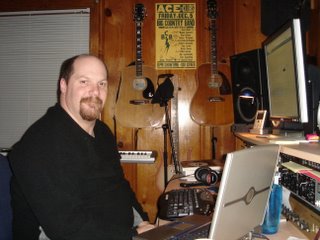If You Node What I Mean
Aha. Nodes. Nodes are the Devil. Nodes are coloring my mix. They must be stopped, but will our hero buy wall treatments in time? Possibly. I had reached an impasse with the mixes. They sounded pretty good, but were bass-shy and the vocal was too compressed. Living in Nashville, where you can't throw a biscuit without hitting a studio had it's advantages. I called on Dave Martin, proprietor of Java Jive Sudios in nearby Joelton to perform a sonic exorcism. He discovered that the very spot where I m sitting is in one of the null points of my room. Frequencies are cancelled out and I hear less bass (so I compensate by adding bass), which makes mixes out in the real world way too bass heavy. Solution: push back from the desk 2-3 feet and listen. Voila. It sounds good again.
The over-compressed vocal problem is solved with good old fashioned vocal rides with a mouse on a virtual fader...which brings the issue of having a hardware contoller front and center again. Dave spent four hours here sizing things up and gave me some things to work on. I have, and the improvements are readily apparent.
I re-tracked a couple of acoustic guitar parts that sounded thin, and that certainly helped. At the time I first tracked them, I used the handiest pre the studio had, a Focusrite Green Series, which is OK, but very different sounding than the Universal Audio LA-610 that I now own. The LA-610 is a tube channel that mimics the legendary UA 610 mic pre and LA-2A compressor. Very fat and punchy. The J-45 that I used for the initial tracking was replaced by my 1968 Epiphone El Dorado, a much more "Martin-y" sounding acoustic guitar.
DVD rental tip of the day: Find a copy of "Tom Dowd: The Language of Music". Dowd was the engineer/producer on most of the music that mattered in the late '50's through the '70's - from Ray Charles, Aretha Franklin, and Otis Redding to Derek and the Dominos and Cream. Oh, and he was a member of the team that worked on the Manhattan Project during WWII. An amazing American life story.
As Ray Charles says in the movie - "How does it sound, baby? How does it sound?"
The over-compressed vocal problem is solved with good old fashioned vocal rides with a mouse on a virtual fader...which brings the issue of having a hardware contoller front and center again. Dave spent four hours here sizing things up and gave me some things to work on. I have, and the improvements are readily apparent.
I re-tracked a couple of acoustic guitar parts that sounded thin, and that certainly helped. At the time I first tracked them, I used the handiest pre the studio had, a Focusrite Green Series, which is OK, but very different sounding than the Universal Audio LA-610 that I now own. The LA-610 is a tube channel that mimics the legendary UA 610 mic pre and LA-2A compressor. Very fat and punchy. The J-45 that I used for the initial tracking was replaced by my 1968 Epiphone El Dorado, a much more "Martin-y" sounding acoustic guitar.
DVD rental tip of the day: Find a copy of "Tom Dowd: The Language of Music". Dowd was the engineer/producer on most of the music that mattered in the late '50's through the '70's - from Ray Charles, Aretha Franklin, and Otis Redding to Derek and the Dominos and Cream. Oh, and he was a member of the team that worked on the Manhattan Project during WWII. An amazing American life story.
As Ray Charles says in the movie - "How does it sound, baby? How does it sound?"

